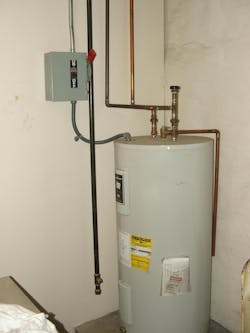Practically Speaking: A Continuous Load Conundrum
I would like to thank Adam Bremer, owner of Bremer Electric in Red Wing, Minn., for presenting a couple of very interesting scenarios when it comes to sizing conductors and overcurrent devices for electric water heaters. He posted questions in the Electrical Code Discussion group on Facebook asking about the sizing requirements for a 6,000W, 208V electric water heater.
The first scenario he asked about was whether a 30A branch circuit wired with 10 AWG copper THHN would be Code compliant. It would not. Section 422.13 requires the branch-circuit overcurrent device and conductors for fixed storage-type water heaters having a capacity of 120 gallons or less to have an ampacity not less than 125% of the rating of the water heater. This 28.8A water heater would need a 40A minimum branch circuit. That seems straightforward. The second scenario gets interesting, though.
Instead of a 30A branch circuit, Adam asked if a 30A feeder wired with 10 AWG THHN supplying a 60A fusible disconnect installed at the water heater location would be Code compliant if there were 40A fuses installed in the disconnect and 8 AWG THHN copper installed from the load-side of the disconnect to the water heater. I told him this scenario would be Code compliant only if the water heater was not considered a continuous load. Section 215.3 requires the feeder overcurrent device to be sized to 125% of the continuous load. The 30A feeder would be too small. However, the 40A branch circuit portion would be perfectly fine. This got me wondering whether this water heater is a continuous load or not. Presently, it is not specifically considered a continuous load. However, looking back on previous editions of the Code revealed an interesting situation.
The 1968 and 1971 editions of the Code did not require 125% sizing and did not specifically state it was a continuous load. Section 422.14(B) of the 1975 edition introduced the requirement that it be considered a continuous load. The 1981 edition was revised “for clarification of intent.” The Code-Making Panel dropped the continuous load wording and added a 125% sizing requirement for the branch circuit. In 2005, Sec. 422.13 considered it a continuous load yet again. The 2008 edition was revised to specify it was a continuous load for the purpose of sizing branch circuits. 2017 was the last edition that specifically noted the water heater was a continuous load. The 2020 edition was revised “for clarity” — one more time dropping the continuous load wording and bringing back the 125% sizing requirements.
So, is it a continuous load or not? It matters when it comes to sizing feeders and services. Maybe a discussion with your AHJ can help you get an answer to this conundrum.
About the Author

Russ LeBlanc
Owner
Russ started in the electrical trade as an apprentice in 1985. He worked his way up to become a Journeyman Electrician and then eventually became a Master Electrician and Licensed Construction Supervisor. In 1999 Russ become an Electrical Instructor for The Peterson School of Engineering in Massachusetts where he developed his passion for teaching, and quickly became Department Head of Electrical Instruction. Russ has taught thousands of apprentices, electricians, engineers, inspectors, and other electrical professionals during his career as an instructor. He continues to provide electrical professionals with Electrical Code seminars, Arc-Flash Awareness training seminars and educational material through his LeBlanc Consulting Services in North Reading, MA whose specialty is educating electricians. He has been an active member of the NFPA Electrical Section and has authored hundreds of National Electrical Code proposals and comments which have become Code rules to improve the safety for the electrical industry. Russ is also an IAEI certified Electrical Inspector.
Please visit www.russleblanc.net for more information.

